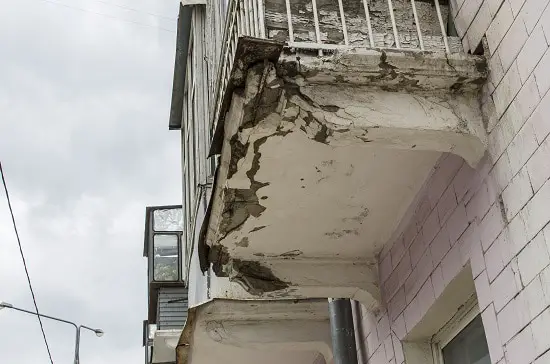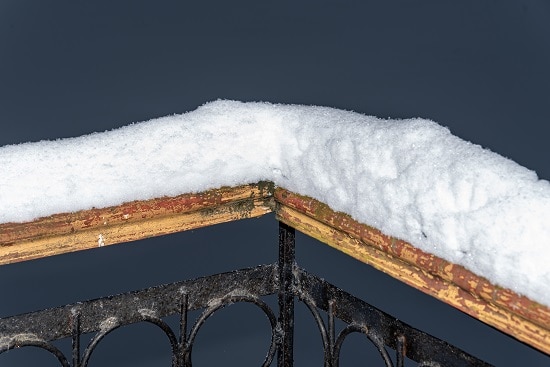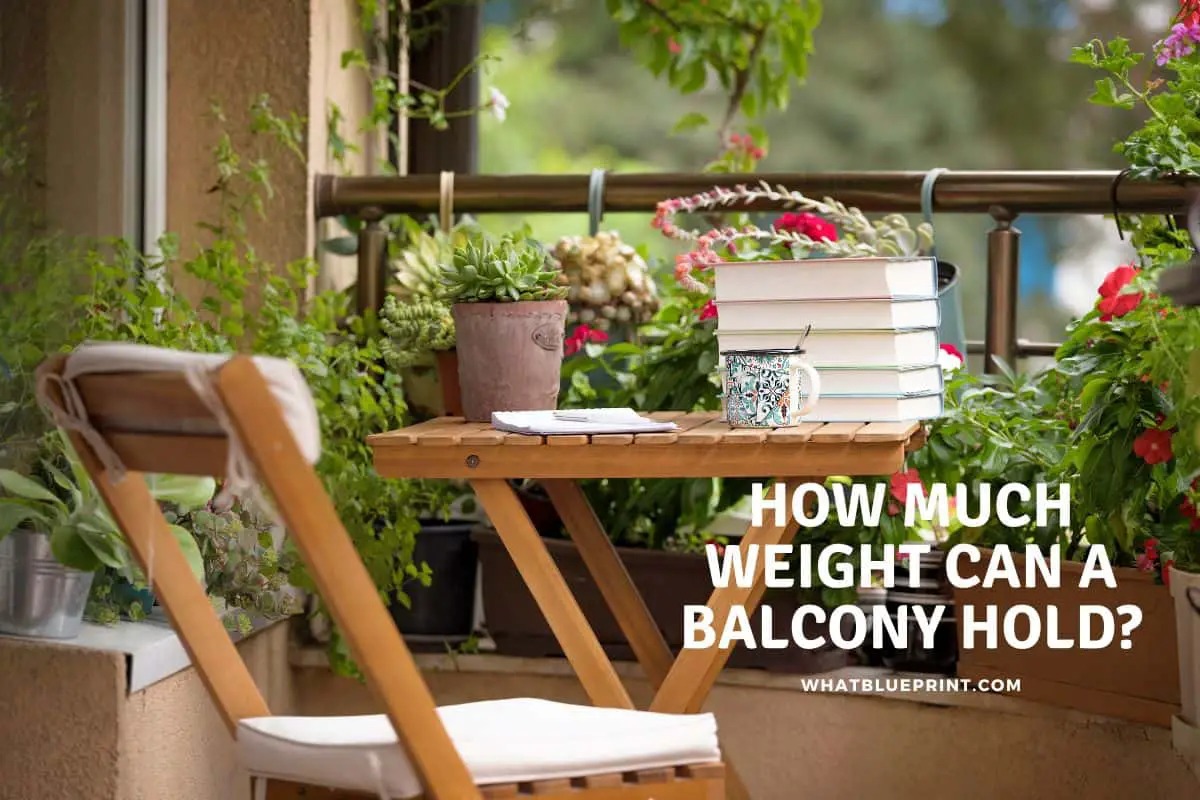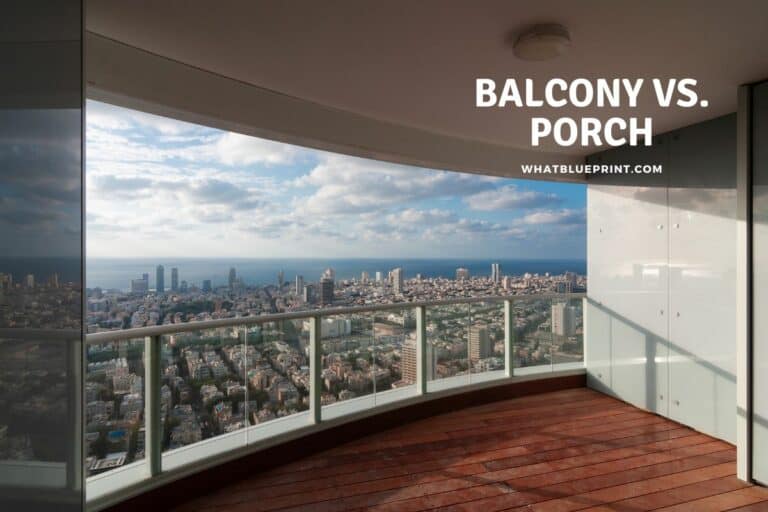How Much Weight Can A Balcony Hold?
Many people enjoy using their balcony to enjoy the outdoors, whether it is a sunset view or a place to unwind with the family. Depending on how big that balcony may be though, poses the question of how much weight your balcony can hold, and how safe it will be for what you intend to do and put on it. We take a look at the answers below.
A balcony is typically constructed to hold 50 – 100 lbs. of load per square foot. While this is considerable items like hot tubs or pools can exceed these limits. Load limits vary depending on balcony construction. Cantilevered balconies offer the most weight support followed by post and bracket-supported balconies
Balconies can be constructed from different materials, such as wood, concrete, and steel, and all of them will support between 50 to 100 lbs of weight per square foot provided they are taken care of.
However, there are factors that will impact this load and weight limit, including construction materials, age, items placed on the balcony, maintenance, size, and construction method and we will explore these below and look at some signs to look out for to ensure your and your families safety.

Average Weight A Balcony Can Hold
Whether you are a homeowner considering constructing a balcony, or live in an apartment that is fortunate enough to have a balcony. It is important to consider what you are planning to put on it and if the load limits and condition of your balcony will accommodate these plans.
As we mentioned above balconies typically are constructed to hold a weight of between 50 to 100 lbs. per square ft. While this is plenty of most use cases, there are heavier uses that need to be researched depending on the factors we will discuss in the following article.
For example, if you want of have access to a small and cozy balcony, you should be aware that it will be unlikely to hold heavy furniture items, of course the size available will be limiting as well. However, if small then realistically you are likely planning a small table a couple of chairs and maybe some greenery which if a well and properly maintained balcony this combined weight will be absolutely fine.
Generally speaking, small balconies of 6 to 8 feet long should hold about 4-8 people and unless these people are very small, there wouldn’t physically be room for more than that anyway. Especially if you have chairs and a table set up on there as well.
We will discuss construction types in a little more detail in sections below, but if your balcony is on a home (rather than an apartment) it maybe it is supported by vertical posts or by brackets. While these are perfectly acceptable ways to construct a balcony, and will still support considerable weight, they are not as strong as cantilevered balconies more often found in apartment blocks.
Without getting structural engineers is the only fully accurate way of assess the loadmits and strength of your balcony, if you know it is bracketed or uses post supports then you should be aware that is is likely to support less than cantilevered construction.
Is Your Balcony Safe?
Many accidents involving balconies are, perhaps surprisingly, down to user error rather than poor maintenance, or not up to code and not built or inspected accurately. So before using your balcony, you should take all the necessary safety measures and ensure that the balcony is safe for use and equally importantly the people using it are safe to do so.
We take a look at some of the things to be aware of when you are constructing or using a ready installed balcony
- How old is your wood – When you build your balcony from wood, you should ensure it consists of new and sturdy wood, not old and rotten wood. Any metal rust or wood rot will increase the risk of accidents. When you inspect your wood, look for any porous or flaky wood. Use a screwdriver or rod to poke it, and if it crumbles, you should replace the wood
- Are your railings sturdy – Your railings should be at least 36 inches high (48 inches for commercial properties) and durable. If they aren’t, you need to replace them right away. In addition, it essential to replace any loose or rotting railing as it can be a safety hazard
- Are nails holding up your balcony – If any nails are holding up your balcony, then it’s not up to code. Nails can’t hold heavy structural work as they don’t grip the walls and support the weight of the frame never mind any additional loads.
- Be aware of peoples using balconies: Many accidents are from poor judgement. if you are having a party, or if there are many people make sure there are rules for using the balconies in your home. No glasses, no climbing, not too many people etc. If you have children or pets make sure they are supervised at all times.
- Consider installing Balcony Netting: While the stability of balconies is often the most considered of dangers there are others. Pigeons and other disease carrying animals can set up home ( we have an article on pigeon nests here) and netting will stop things falling over to the ground or balconies below, btu they will also help to prevent birds from using your balcony as well.

Is It Possible To Overload Your Balcony?
With all balconies they will read a breaking point, though this is VERY unlikely to ever be reached with general use. However there are some items and materials to be aware of the most common two of these are potted plants and water.
Hot Tubs on a balcony. It seems like such a great idea, relaxing in a hot tub or an inflatable pool on a balcony. ( we actually have some articles on hot tubs and inflatable pools on balconies on the site.) However adding the weight of water in great qualities is not a great idea.
Water can weigh upwards of 60 lbs a cubic metre, putting it already over the lower load bearing weight of a balcony and add to that the construction wight of a hot tub ( if permanent) and of course the people in the hot tub and it will start to get dangerously close to the upper weight limits of balconies. The same applies to inflatable pools of course.
Although some higher end apartment building may have structural reinforcements built in to the balcony to support pools or hot tubs most if not already built in will not.
Potted plants on first instance seem to be totally fine to put on a balcony, and they are, as long as they are not creating a mini jungle out there. Pots, especially ceramic and terracotta are heavy, and filled with soil as well as the plant or tree itself all add to the weight.
As a rule if you are putting just a few plants onto your balcony then it will be fine, just dont go over the top!
Although, it is possible to overload a balcony with people, but its really very unusual to see people crammed together in such a small space without a breathing room.
Does Construction Type of Balconies and Weight.
The three main construction methods for balconies are Cantilevered, post and bracket supported and while all three are safe for general use they do have differences that add to load limits. We take a look at these below.
- Cantilevered Balconies. Concrete cantilevered balconies, especially with a ratio of 1-3 (one third of the concrete is balcony and 2 thirds are extended into the room the balcony is attached to) are some of the strongest and can bear the heaviest loads.
- Post supported: These balconies are supported from posts with foundations on the ground, and while the support can vary depending on the strength of these supporting posts they are generally not as strong as full concrete cantilevered balconies.
- Bracket support / Steel rods: These balconies are constructed to be supported by either brackets underneath, or by rods holding the balcony up from above or at the side. They are used frequently in Juliet and french balconies and again are not able to bear a load as heavy as concrete slabs,
How To Tell If Your Balcony Is Going To Fall Down?
We have a larger article on the site that covers if your balcony is going to fall down in more detail. ( you can follow the link) but in a nutshell if you spot any of the following you should seek professional advice earlier rather than later.
- Cracking in walls and in floors: If these were present when you moved in, and have been checked, then you need to monitor them to make sire they dont get worse
- White powder: if you spot this it may be a sign that water is inside the concrete and rusting the steel supporting rods and joists.
- Icicles: Look for these above and below your balcony. There are a very clear sign there is water working through the balcony, and possibly from the balcony above ( which is a danger as well of course)
- Bumps, or loose tiles on the balcony floor. This could indicate movement in the balcony concrete that remain unseen.
- Rusted railings: although it looks superficial if the water is working its way into the settings of the railing it could weaken them significantly.
- Creaking or groaning ( especially wood): If you have a wooden balcony be aware of movement and sounds. If the balcony is suffering from rot it should be easier to spot, but these sounds will also indicate there maybe a structural issue as well.

We have a selection of balcony construction and common questions linked below with loads more information.
- How far can you cantilever a balcony
- Types of balcony support brackets
- what is the average balcony size
- how to support a balcony without posts
- can you have a balcony pully system
- What is the standard height of balcony railings
- Does balcony glass need to be laminated
- how much does it cost to replace a balcony
- how much weight can a balcony hold
- How to build a floating balcony
Conclusion
As we mentioned above a well maintained balcony will support between 50 – to 100 lbs. of load, depending on the construction type of the balcony, and including the actual weight of the balcony structure.
However, it is important not only to check the condition and maintenance of your balcony on a regular basis but also to make sure you are aware of what you put on and how you use the balcony as most accidents will occur from misusing the balcony rather than the balcony failing due to overloading.
References
- https://www.quora.com/How-much-weight-can-be-on-a-balcony
- https://www.terracastproducts.com/the-importance-of-lightweight-pots-for-balconies/
- https://www.liherald.com/stories/can-i-overload-my-balcony,137406
- https://www.reddit.com/r/NoStupidQuestions/comments/jd16od/how_much_weight_can_an_apartment_floor_and/







